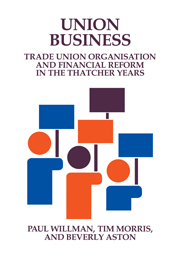Book contents
- Frontmatter
- Contents
- Acknowledgements
- 1 Introduction: unions in the 1980s
- 2 The financial status of British trade unions 1950–1989
- 3 Financial differences between unions
- 4 The role of financial matters in union organisation
- 5 The politics of union finaces
- 6 Union size, growth, and financial performance
- 7 Strike activity and union finances
- 8 The National Union of Mineworkers: strikes and financial disaster
- 9 The GMB: merger and financial reform
- 10 The Amalgamated Engineering Union: back from the brink
- 11 The Banking, Insurance and Finance Union: competitive unionism and financial survival
- 12 The Electrical, Electronic, Telecommunications and Plumbing Trade Union: accountability and financial control
- 13 Conclusions: union business and business unionism
- Appendix 1 Research methods
- Appendix 2 Regression results
- Appendix 3 Questions for finance officers
- Appendix 4 Questions for General Secretaries
- Appendix 5 Questionnaire: trade union finances
- Appendix 6 The number of trade unions
- Notes
- References
- Subject index
- Index of trade unions
- Author index
9 - The GMB: merger and financial reform
Published online by Cambridge University Press: 11 March 2010
- Frontmatter
- Contents
- Acknowledgements
- 1 Introduction: unions in the 1980s
- 2 The financial status of British trade unions 1950–1989
- 3 Financial differences between unions
- 4 The role of financial matters in union organisation
- 5 The politics of union finaces
- 6 Union size, growth, and financial performance
- 7 Strike activity and union finances
- 8 The National Union of Mineworkers: strikes and financial disaster
- 9 The GMB: merger and financial reform
- 10 The Amalgamated Engineering Union: back from the brink
- 11 The Banking, Insurance and Finance Union: competitive unionism and financial survival
- 12 The Electrical, Electronic, Telecommunications and Plumbing Trade Union: accountability and financial control
- 13 Conclusions: union business and business unionism
- Appendix 1 Research methods
- Appendix 2 Regression results
- Appendix 3 Questions for finance officers
- Appendix 4 Questions for General Secretaries
- Appendix 5 Questionnaire: trade union finances
- Appendix 6 The number of trade unions
- Notes
- References
- Subject index
- Index of trade unions
- Author index
Summary
Historical background
GMB is currently the second largest union in the UK, following the merger between GMBATU and APEX in 1989. GMBATU itself was a relatively new creation, following from the merger between GMWU and the Boilermakers' union in 1982, but both unions had a much longer history. The numerically larger GMWU was founded by merger of three municipal and labouring unions in 1924, but its roots go back to the gasworkers' militancy of the 1880s. In the post-war period, GMWU membership has been concentrated in six sectors; namely, engineering, food drink and tobacco, gas, chemicals, electricity, and local authority employment. However, it also has members in the NHS, in the water industry, in textiles and, more recently, in catering and distribution. It is strongest in the north-east and north-west.
GMB competes with a wide range of both public- and private-sector unions but most notably with the Transport and General Workers' Union (T&G). The older GMWU differed in a number of respects from T&G, most notably in its attitude towards shop stewards and industrial action. During the 1960s, when T&G were decentralising activities towards shop stewards, GMWU was involved in a number of conflicts over steward independence, most notably at Ford and Pilkingtons (Eaton and Gill, 1983: 317). At the time the union had a rather staid, right-wing image and remained highly centralised.
Unlike T&G, GMWU was relatively unattractive as a merger partner, in part because of its image but more because of its strong regional structure. It was, in Undy et al.'s terms ‘restrictive-passive’ in its orientation to growth, compared with the ‘positive-expansionist’ approach of T&G.
- Type
- Chapter
- Information
- Union BusinessTrade Union Organisation and Financial Reform in the Thatcher Years, pp. 140 - 153Publisher: Cambridge University PressPrint publication year: 1993



